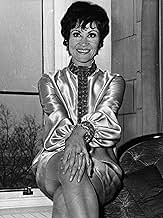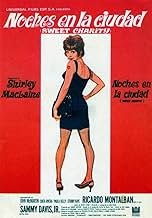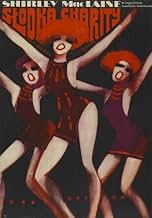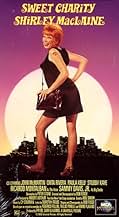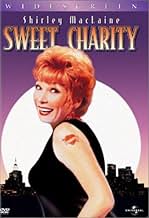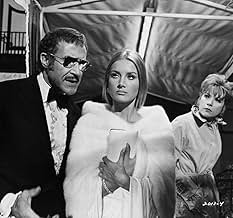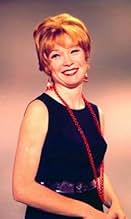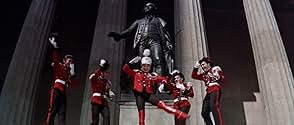Sweet Charity
- 1969
- Tous publics
- 2h 29min
NOTE IMDb
6,9/10
7,4 k
MA NOTE
Ajouter une intrigue dans votre langueA luckless taxi dancer in New York City seeks a better life and finds love along the way.A luckless taxi dancer in New York City seeks a better life and finds love along the way.A luckless taxi dancer in New York City seeks a better life and finds love along the way.
- Réalisation
- Scénario
- Casting principal
- Nommé pour 3 Oscars
- 6 nominations au total
Dante DiPaolo
- Charlie
- (as Dante D'Paulo)
Leon Alton
- Dancer
- (non crédité)
Avis à la une
I notice that uncredited, but still making a vital contribution to this film was the original Broadway lead Gwen Verdon who assisted her then husband Bob Fosse with the choreography. This has to be one of the truly unselfish acts in a business that's built on ego.
Sweet Charity ran 608 performances on Broadway with a flock of Tony Award nominations including Gwen Verdon for the lead of Charity Hope Valentine and two Tony Awards for Bob Fosse for direction and choreography. Fosse came over to Hollywood to repeat his dual roles. But instead of Gwen doing the lead, Shirley MacLaine steps into the part and Gwen assists in the choreography. Quite frankly had she told Universal and her then husband to take their film and follow explicit directions what to do with it, who could have blamed her.
Yet there was Gwen Verdon, helping another performer do good in a part she created. Shirley MacLaine did do good in the role and it was a return to MacLaine's own musical roots. Shirley MacLaine has done so many dramatic roles and been Oscar nominated and once a winner for them, people do forget her beginnings were musical. Had she come along ten years earlier she would have been a great musical star. As it is she does have films like Can Can, Artists and Models, and What A Way To Go where we see Shirley singing and dancing. Her first big break was on Broadway replacing Carol Haney in Pajama Game.
Charity Hope Valentine, someone who is charging more than 10 Cents a Dance Depression prices in a dance hall keeps having the worst luck in men which is established early on when at the beginning a guy she was just getting interested in threw her off a bridge into Central Park lake and robbed her purse. The latest in a long line of romantic failures. But quite by accident she gets involved with two men, Italian film star Ricardo Montalban and insurance actuary John McMartin who is repeating his role from the original Broadway production.
The Cy Coleman-Dorothy Fields score is a bit cut down, but you couldn't do Sweet Charity without Hey Big Spender and If They Could See Me Now. In the latter Shirley's musical talents, singing and dancing, get their full range. It must have been something however to see Gwen Verdon cavorting around the Italian film star's apartment doing that soliloquy of finally hitting the big time and wishing her dance hall girls could see here.
As for the dance hall girls, Shirley's peers are led by best friends Chita Rivera and Paula Kelly who along with Shirley do the big production number of Hey Big Spender. Who wouldn't want a little quality time with any one of them.
And we get a special treat with Sammy Davis, Jr. doing the Rhythm Of Life church, a satire on those who claim religious tax exempt status for some interesting beliefs. It maybe his best musical moment in film.
The ending for a musical is rather unusual, I can't reveal, but nothing similar comes to mind at the moment. Though Shirley MacLaine is great, poor Gwen Verdon died having only had one of her Broadway hits filmed, Damn Yankees.
But Gwen was quite the girl helping someone else score a hit with her role.
Sweet Charity ran 608 performances on Broadway with a flock of Tony Award nominations including Gwen Verdon for the lead of Charity Hope Valentine and two Tony Awards for Bob Fosse for direction and choreography. Fosse came over to Hollywood to repeat his dual roles. But instead of Gwen doing the lead, Shirley MacLaine steps into the part and Gwen assists in the choreography. Quite frankly had she told Universal and her then husband to take their film and follow explicit directions what to do with it, who could have blamed her.
Yet there was Gwen Verdon, helping another performer do good in a part she created. Shirley MacLaine did do good in the role and it was a return to MacLaine's own musical roots. Shirley MacLaine has done so many dramatic roles and been Oscar nominated and once a winner for them, people do forget her beginnings were musical. Had she come along ten years earlier she would have been a great musical star. As it is she does have films like Can Can, Artists and Models, and What A Way To Go where we see Shirley singing and dancing. Her first big break was on Broadway replacing Carol Haney in Pajama Game.
Charity Hope Valentine, someone who is charging more than 10 Cents a Dance Depression prices in a dance hall keeps having the worst luck in men which is established early on when at the beginning a guy she was just getting interested in threw her off a bridge into Central Park lake and robbed her purse. The latest in a long line of romantic failures. But quite by accident she gets involved with two men, Italian film star Ricardo Montalban and insurance actuary John McMartin who is repeating his role from the original Broadway production.
The Cy Coleman-Dorothy Fields score is a bit cut down, but you couldn't do Sweet Charity without Hey Big Spender and If They Could See Me Now. In the latter Shirley's musical talents, singing and dancing, get their full range. It must have been something however to see Gwen Verdon cavorting around the Italian film star's apartment doing that soliloquy of finally hitting the big time and wishing her dance hall girls could see here.
As for the dance hall girls, Shirley's peers are led by best friends Chita Rivera and Paula Kelly who along with Shirley do the big production number of Hey Big Spender. Who wouldn't want a little quality time with any one of them.
And we get a special treat with Sammy Davis, Jr. doing the Rhythm Of Life church, a satire on those who claim religious tax exempt status for some interesting beliefs. It maybe his best musical moment in film.
The ending for a musical is rather unusual, I can't reveal, but nothing similar comes to mind at the moment. Though Shirley MacLaine is great, poor Gwen Verdon died having only had one of her Broadway hits filmed, Damn Yankees.
But Gwen was quite the girl helping someone else score a hit with her role.
"Hey big spender" That's all I knew about Sweet Charity. A musical version of Federico Fellini's masterpiece "The Nights Of Cabiria" - I didn't think of Cabiria when I saw Charity on the screen. Shirley MacLaine's recreates and reinvents Giulietta Masina's Cabiria. That is something that very rarely works. But here in Bob Fosse's version, Cabiria has a new life, an American life, a song and dance life but just as sad. Sad but not hopeless. There is the spirit of Cabiria/Charity that will survive. Shirley MacLaine is magnificent. She manages to project that innocence that makes everything not just palatable but delicious.
Bob Fosse's first opportunity to direct a movie was the 1969 film version of his own Broadway musical SWEET CHARITY, a musical based on the film NIGHTS OF CABERIA, with a book by Neil Simon and music by Cy Coleman and Doothy Fields. The story is best described by the film's subtitle: "The Adventures of a Girl Who Wants to be Loved". Shirley MacLaine, taking over the title role from Fosse's wife and muse, Gwen Verdon, plays Charity Hope Valentine, a pathetic thing who has worked as a taxi dancer in the Fandango Ballroom for eight years and has basically been a doormat to men all her life. As her friend Nickie (Chita Rivera) explains, "You run you heart like a hotel...you got men checking in and checking out all the time." The story is told in a series of amusing and touching vignettes which lead to Charity meeting the possible man of her dreams, a milquetoast named Oscar Lindquist (John McMartin, reprising his Broadway role). This film died at the box office in 1969 and I'm not sure why except for the fact that this was a period when musicals just weren't being made anymore and that's a shame because the movie is extremely entertaining, thanks to the bravura performance by MacLaine as Charity and the extraordinary choreography by Bob Fosse. I can watch this movie over and over again just to watch the dance numbers. The raw sensuality of "Hey Big Spender"...the angular, disjointed and pointed moves of "Rich Man's Frug"...the Broadway exuberance of "There's Gotte be Something Better Than This", exuberantly danced by MacLaine, Rivera, and Paula Kelly...the brilliant jazzy classic Fosse moves of "Rhythm of Life"..and the pure joy of "I'm a Brass Band." All of Fosse's choreographic signatures are present here...the hats, the gloves, the turned in feet, the disjointed body parts, the expressionless dancer faces, it's all here to be watched and studied and marveled over. For dance purists and Fosse devotees, SWEET CHARITY is a must.
Shirley MacLaine is excellent in this underrated, brassy musical based on the Italian classic film, NIGHTS OF CABIRIA.
MacLaine plays Charity Hope Valentine, a sweet but rather clueless woman who works in a dance hall but yearns for love. She's constantly linking up with men who use her, take her money, dump her. The film opens with Charity in Central Park with her "boyfriend." Sitting on a bridge, she chirps about making a wish and throwing something off the bridge. The creep shoves her into the water.
She has two wiser-but-cynical pals, played by Chita Rivera and Paula Kelly. They seem resigned to their fates as dance hall girls but there's still an ember of hope for a better life.
Charity meets an Italian film star (Ricardo Montalban) and spend the night with him ... in his closet. She then meets a repressed man (John McMartin) in a stalled elevator and seems to have found happiness at last..... But is happiness in the cards for Charity? MacLaine seems to channel Gwen Verdon (who starred in the show on Broadway and who worked with MacLaine on the dance numbers) and excels in the many productions numbers, especially "If They Could See Me Now" and "Somebody Loves Me at Last." MacLaine also has a spirited rooftop dance number with Rivera and Kelly as they opine "There's Gotta Be Something Better Than This." The show-stopper is probably the "Big Spender" number which features MacLaine, Rivera, and Kelly with a line of dance hall girls who try to lure men to be their partners. It's a sensational number that shows Bob Fosse's choreographic skills and also demonstrates the cynical life of a dance hall girl.
Other great numbers include MacLaine and Montalban's visit to the Pompeii Club where the dancers go through a series of landmark Fosse dances. The lead dancer here is the sensational Suzanne Charny. Among the dancers are also Ben Vereen, Lee Roy Reams, and Chelsea Brown.
Sammy Davis turns up the heat with the "River of Life" number which shows Charity and Oscar (McMartin)seeking meaning and discovering the 60s counter culture. Then there's Stubby Kaye as the dance hall manager who throws Charity a wedding party and sings "I Love to Cry at Weddings." This is a hugely underrated musical filled with great music and production numbers. Big, bright, brassy, and brazen, what's not to love? MacLaine won a Golden Globe nomination.
MacLaine plays Charity Hope Valentine, a sweet but rather clueless woman who works in a dance hall but yearns for love. She's constantly linking up with men who use her, take her money, dump her. The film opens with Charity in Central Park with her "boyfriend." Sitting on a bridge, she chirps about making a wish and throwing something off the bridge. The creep shoves her into the water.
She has two wiser-but-cynical pals, played by Chita Rivera and Paula Kelly. They seem resigned to their fates as dance hall girls but there's still an ember of hope for a better life.
Charity meets an Italian film star (Ricardo Montalban) and spend the night with him ... in his closet. She then meets a repressed man (John McMartin) in a stalled elevator and seems to have found happiness at last..... But is happiness in the cards for Charity? MacLaine seems to channel Gwen Verdon (who starred in the show on Broadway and who worked with MacLaine on the dance numbers) and excels in the many productions numbers, especially "If They Could See Me Now" and "Somebody Loves Me at Last." MacLaine also has a spirited rooftop dance number with Rivera and Kelly as they opine "There's Gotta Be Something Better Than This." The show-stopper is probably the "Big Spender" number which features MacLaine, Rivera, and Kelly with a line of dance hall girls who try to lure men to be their partners. It's a sensational number that shows Bob Fosse's choreographic skills and also demonstrates the cynical life of a dance hall girl.
Other great numbers include MacLaine and Montalban's visit to the Pompeii Club where the dancers go through a series of landmark Fosse dances. The lead dancer here is the sensational Suzanne Charny. Among the dancers are also Ben Vereen, Lee Roy Reams, and Chelsea Brown.
Sammy Davis turns up the heat with the "River of Life" number which shows Charity and Oscar (McMartin)seeking meaning and discovering the 60s counter culture. Then there's Stubby Kaye as the dance hall manager who throws Charity a wedding party and sings "I Love to Cry at Weddings." This is a hugely underrated musical filled with great music and production numbers. Big, bright, brassy, and brazen, what's not to love? MacLaine won a Golden Globe nomination.
Sure, Bob Fosse sometimes indulges in trendy late-60's stylistic touches like freeze-frames and crash-zooms. Some of the jokes by Neil Simon are corny, and Shirley MacLaine can be a little hard to take sometimes. The film also suffers from the bloated, over-produced quality that infected most 60's major studio musicals.
The dull non-musical scenes are a chore to sit through, but when one of Fosse's amazing production numbers begins, Sweet Charity soars into the sublime. Fosse was quite simply a genius, and the great showcase numbers such as "Hey Big Spender" and "Rich Man's Frug" are as brilliant as any dance numbers ever put on film.
Shifting configurations of dancers, contorted body poses, dance steps that are by turns awkward and graceful, a studied contrast between clustering dancers and separating dancers -- it is hard to describe the magic of the Pompeii Club sequence. I've always felt that Fosse's choreography has the same sense of space and volume as Cubist painting.
Fosse's camera placement and camera movement capture an ideal "in-the-round" feeling of choreographed numbers that one cannot experience in the theater. For a first-time film director, Fosse revealed an amazing facility for the form. Usually theater directors don't take to the medium of film as quickly as Fosse did. Usually, theater directors make visually unexciting films that feel stage-bound. Not Fosse -- Sweet Charity, despite some flaws, doesn't play like a filmed stage play, it has the visual panache of Fellini and Godard.
Sweet Charity was just a warm-up, Fosse's personal film school at Universal's expense, before he truly mastered the form of film-making with the classic Cabaret.
The dull non-musical scenes are a chore to sit through, but when one of Fosse's amazing production numbers begins, Sweet Charity soars into the sublime. Fosse was quite simply a genius, and the great showcase numbers such as "Hey Big Spender" and "Rich Man's Frug" are as brilliant as any dance numbers ever put on film.
Shifting configurations of dancers, contorted body poses, dance steps that are by turns awkward and graceful, a studied contrast between clustering dancers and separating dancers -- it is hard to describe the magic of the Pompeii Club sequence. I've always felt that Fosse's choreography has the same sense of space and volume as Cubist painting.
Fosse's camera placement and camera movement capture an ideal "in-the-round" feeling of choreographed numbers that one cannot experience in the theater. For a first-time film director, Fosse revealed an amazing facility for the form. Usually theater directors don't take to the medium of film as quickly as Fosse did. Usually, theater directors make visually unexciting films that feel stage-bound. Not Fosse -- Sweet Charity, despite some flaws, doesn't play like a filmed stage play, it has the visual panache of Fellini and Godard.
Sweet Charity was just a warm-up, Fosse's personal film school at Universal's expense, before he truly mastered the form of film-making with the classic Cabaret.
Le saviez-vous
- AnecdotesAlthough uncredited, Gwen Verdon was assistant choreographer in the film version of Sweet Charity (1969).
- GaffesIn the "Aloof" movement of "The Rich Man's Frug," two of the male principal dancers walk down the stairs to light a woman's cigarette, while the others dance behind them. The background choreography in this shot leads directly to the triangle formation of the next shot, and the two men are now in the middle of the group, although there was no time for them to reach that position.
- Citations
Charity Hope Valentine: Wow! This place sure is crawlin' with celebrities. I'm the only person here I never heard of.
- Versions alternativesLaserdisc version contains an alternative ending. After Oscar leaves Charity, he starts to go crazy in his apartment. He then realizes that despite Charity's faults, he really can't live without her. He finds Charity on the bridge in Central Park and, thinking she's going to jump, falls into the river. Charity jumps in after Oscar and forgives him. The two then walk off together, soaking wet, through the park. Bob Fosse thought this ending was too corny, and decided to use the depressing, yet more inspirational, ending for the film's major release.
- ConnexionsFeatured in Sweet Charity: From the Stage to the Screen (1969)
- Bandes originalesMy Personal Property
(uncredited)
Music by Cy Coleman
Lyrics by Dorothy Fields
Performed by Shirley MacLaine
Meilleurs choix
Connectez-vous pour évaluer et suivre la liste de favoris afin de recevoir des recommandations personnalisées
- How long is Sweet Charity?Alimenté par Alexa
Détails
- Date de sortie
- Pays d’origine
- Langue
- Aussi connu sous le nom de
- Sweet Charity: The Adventures of a Girl Who Wanted to Be Loved
- Lieux de tournage
- Société de production
- Voir plus de crédits d'entreprise sur IMDbPro
Box-office
- Budget
- 20 000 000 $US (estimé)
- Durée
- 2h 29min(149 min)
- Rapport de forme
- 2.35 : 1
Contribuer à cette page
Suggérer une modification ou ajouter du contenu manquant


